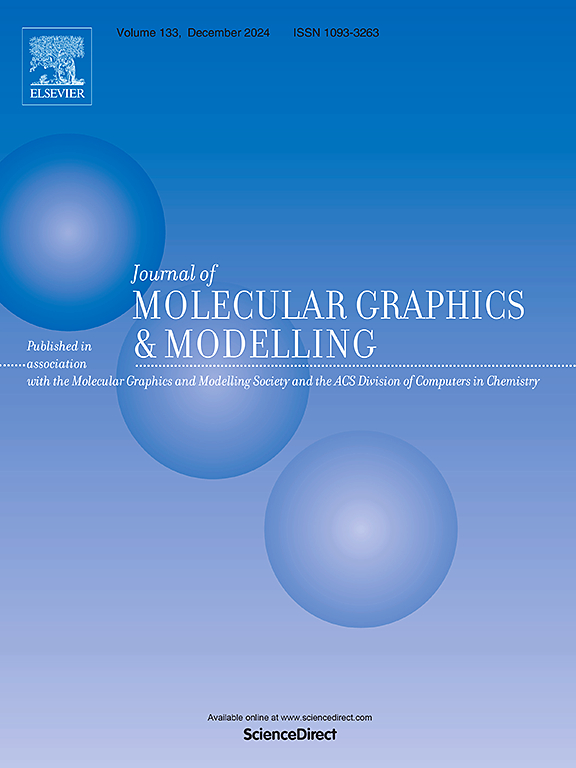通过计算方法揭示artopetelin类黄酮作为过氧化物酶体增殖物激活受体- δ (PPARδ)激动剂的治疗潜力
IF 3
4区 生物学
Q2 BIOCHEMICAL RESEARCH METHODS
引用次数: 0
摘要
糖尿病是一个日益受到全球关注的健康问题,过氧化物酶体增殖物激活受体δ (PPARδ)由于其在葡萄糖调节中的作用而成为一个有希望的治疗靶点。黄酮类化合物是一类植物源性生物活性化合物,以其抗糖尿病特性而闻名。本研究旨在利用一系列计算方法探索artopetelin类黄酮作为PPARδ激活剂的潜力。分子对接(MD)计算确定了6个artopetelin配体,它们的结合亲和力超过了天然配体(−10.4 kcal/mol)和参比药物如elafbranor(−10.0 kcal/mol)和seladelpar(−9.8 kcal/mol)。artopetelin A的结合亲和力最高,为−11.8 kcal/mol。除artopetelin B外,所有候选物都结合在受体的催化位点,提示竞争性活化的潜力。前5个配合物的分子动力学模拟(MDS)结果显示其结构稳定,具有一致的均方根偏差(RMSD)分布和稳定的氢键模式。吉布斯自由能变化(ΔGBFE <;0)证实了络合生成反应的持续热力学自发性,其值在−39.88 ~−26.66 kcal/mol之间。通过pkCSM进行的药代动力学预测显示了良好的药物相似性和ADMET谱。这些初步的硅研究结果强调了前五种artopetelin类黄酮作为2型糖尿病治疗的PPARδ激活剂的巨大潜力,强调了它们作为植物源性治疗剂的前景,并需要进一步的实验验证。本文章由计算机程序翻译,如有差异,请以英文原文为准。

Unveiling the therapeutic potential of artopetelin flavonoids through computational approaches as peroxisome proliferator-activated receptor-delta (PPARδ) agonists
Diabetes mellitus is a growing global health concern, with peroxisome proliferator-activated receptor-delta (PPARδ) emerging as a promising therapeutic target due to its role in glucose regulation. Flavonoids, a class of plant-derived bioactive compounds, are known for their anti-diabetic properties. The present study aims to explore the potential of artopetelin flavonoids as PPARδ activators using a range of computational approaches. Molecular docking (MD) calculations identified six artopetelin ligands with binding affinities surpassing those of the native ligand (−10.4 kcal/mol) and the reference drugs such as elafibranor (−10.0 kcal/mol) and seladelpar (−9.8 kcal/mol). The highest binding affinity was obtained for artopetelin A, with a value of −11.8 kcal/mol. All candidates, except artopetelin B, were bound at the receptor's catalytic site, suggesting potential for competitive activation. Molecular dynamics simulations (MDS) of the top five complexes revealed structural stability, with consistent root mean square deviation (RMSD) profiles and stable hydrogen bonding patterns. Gibbs free energy changes (ΔGBFE < 0) confirmed the sustained thermodynamic spontaneity of complex formation reactions where the values ranged from −39.88 to −26.66 kcal/mol. Pharmacokinetic predictions via pkCSM indicated favorable drug-likeness and ADMET profiles. These preliminary in silico findings highlight the strong potential of top five artopetelin flavonoids as PPARδ activators for type 2 diabetes management, underscoring their promise as plant-derived therapeutic agents and warranting further experimental validation.
求助全文
通过发布文献求助,成功后即可免费获取论文全文。
去求助
来源期刊

Journal of molecular graphics & modelling
生物-计算机:跨学科应用
CiteScore
5.50
自引率
6.90%
发文量
216
审稿时长
35 days
期刊介绍:
The Journal of Molecular Graphics and Modelling is devoted to the publication of papers on the uses of computers in theoretical investigations of molecular structure, function, interaction, and design. The scope of the journal includes all aspects of molecular modeling and computational chemistry, including, for instance, the study of molecular shape and properties, molecular simulations, protein and polymer engineering, drug design, materials design, structure-activity and structure-property relationships, database mining, and compound library design.
As a primary research journal, JMGM seeks to bring new knowledge to the attention of our readers. As such, submissions to the journal need to not only report results, but must draw conclusions and explore implications of the work presented. Authors are strongly encouraged to bear this in mind when preparing manuscripts. Routine applications of standard modelling approaches, providing only very limited new scientific insight, will not meet our criteria for publication. Reproducibility of reported calculations is an important issue. Wherever possible, we urge authors to enhance their papers with Supplementary Data, for example, in QSAR studies machine-readable versions of molecular datasets or in the development of new force-field parameters versions of the topology and force field parameter files. Routine applications of existing methods that do not lead to genuinely new insight will not be considered.
 求助内容:
求助内容: 应助结果提醒方式:
应助结果提醒方式:


